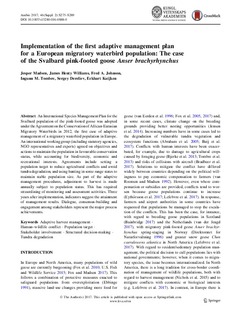| dc.contributor.author | Madsen, Jesper | |
| dc.contributor.author | Williams, James Henty | |
| dc.contributor.author | Johnson, Fred A. | |
| dc.contributor.author | Tombre, Ingunn | |
| dc.contributor.author | Dereliev, Sergey | |
| dc.contributor.author | Kuijken, Eckhart | |
| dc.coverage.spatial | Svalbard, Europe | nb_NO |
| dc.date.accessioned | 2017-05-23T11:34:56Z | |
| dc.date.available | 2017-05-23T11:34:56Z | |
| dc.date.created | 2017-03-02T15:20:17Z | |
| dc.date.issued | 2017 | |
| dc.identifier.citation | Ambio. 2017, 46 (Suppl. 2), S275-S289. | nb_NO |
| dc.identifier.issn | 0044-7447 | |
| dc.identifier.uri | http://hdl.handle.net/11250/2443298 | |
| dc.description.abstract | An International Species Management Plan for the Svalbard population of the pink-footed goose was adopted under theAgreement on theConservation of African-Eurasian Migratory Waterbirds in 2012, the first case of adaptive management of a migratory waterbird population in Europe. An internationalworking group (including statutory agencies, NGO representatives and experts) agreed on objectives and actions to maintain the population in favourable conservation status, while accounting for biodiversity, economic and recreational interests. Agreements include setting a population target to reduce agricultural conflicts and avoid tundra degradation, and using hunting in some range states to maintain stable population size. As part of the adaptive management procedures, adjustment to harvest is made annually subject to population status. This has required streamlining of monitoring and assessment activities. Three years after implementation, indicators suggest the attainment of management results. Dialogue, consensus-building and engagement among stakeholders represent the major process achievements. | nb_NO |
| dc.language.iso | eng | nb_NO |
| dc.rights | Navngivelse 4.0 Internasjonal | * |
| dc.rights.uri | http://creativecommons.org/licenses/by/4.0/deed.no | * |
| dc.subject | Adaptive harvest management | nb_NO |
| dc.subject | Human–wildlife conflict | nb_NO |
| dc.subject | Population target | nb_NO |
| dc.subject | Stakeholder involvement | nb_NO |
| dc.subject | Structured decision-making | nb_NO |
| dc.subject | Tundra degradation | nb_NO |
| dc.title | Implementation of the first adaptive management plan for a European migratory waterbird population: The case of the Svalbard pink-footed goose Anser brachyrhynchus | nb_NO |
| dc.type | Journal article | nb_NO |
| dc.type | Peer reviewed | nb_NO |
| dc.subject.nsi | VDP::Matematikk og naturvitenskap: 400 | nb_NO |
| dc.subject.nsi | VDP::Mathematics and natural scienses: 400 | nb_NO |
| dc.source.pagenumber | S275-S289 | nb_NO |
| dc.source.volume | 46 | nb_NO |
| dc.source.journal | Ambio | nb_NO |
| dc.source.issue | Suppl. 2 | nb_NO |
| dc.identifier.doi | 10.1007/s13280-016-0888-0 | |
| dc.identifier.cristin | 1455436 | |
| dc.relation.project | Norges forskningsråd: 230329 | nb_NO |
| cristin.unitcode | 7511,4,0,0 | |
| cristin.unitname | Tromsø | |
| cristin.ispublished | true | |
| cristin.fulltext | original | |
| cristin.qualitycode | 1 | |

